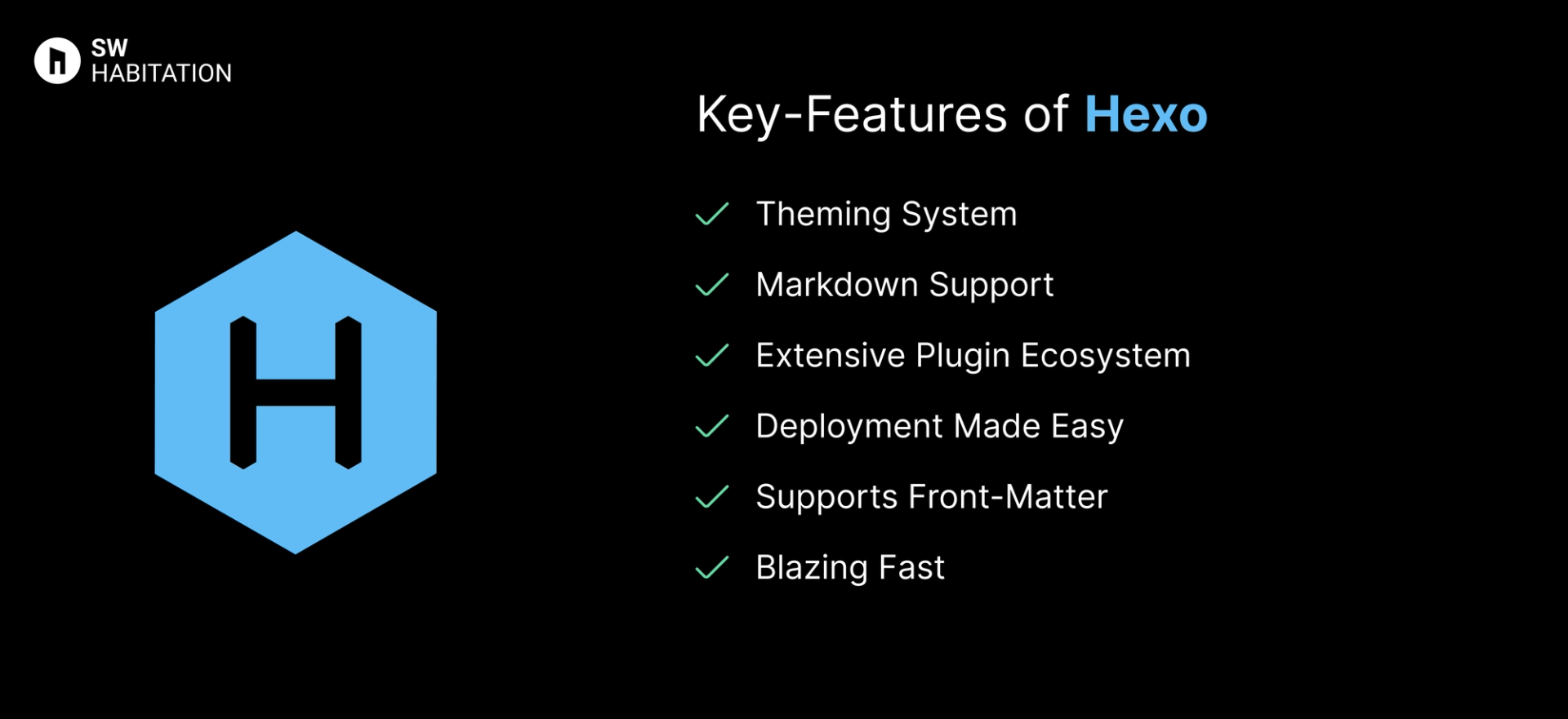Hexo vs. Hugo

Hexo

Hugo
Have you ever been to a website that loads super fast? Chances are it uses an SSG (Static Site Generator). It’s a tool that builds your site ahead of time, so when someone visits, they get the page instantly. No waiting around for things to load it’s just there.
What is Hexo?
Hexo is a Node.js powered static site generator that transforms Markdown files into static HTML pages. It’s particularly popular among bloggers and developers who love the simplicity of Markdown but also want a bit more control over the final website output as well.
Key Features of Hexo


- Theming System: Supports customizable themes for a personalized look.
- Markdown Support: Write your content in Markdown and let Hexo handle the rest.
- Extensive Plugin Ecosystem: Offers a range of plugins for SEO, analytics, and more.
- Deployment Made Easy: One-command deployment to platforms like GitHub Pages or Vercel.
- Supports Front-Matter: Add metadata like titles, tags, and categories to each post.
- Blazing Fast: Generates static files in seconds, even for large websites.
Advantages of Hexo
- Huge Plugin Library: Extend functionality effortlessly.
- Perfect for Blogs: Tailored to bloggers who want to focus on content.
- Minimal Setup: Simple installation and configuration.
- Speed: Lightning-fast build times.
- Markdown Focused: Keeps writing pure and distraction-free.
Disadvantages of Hexo
- Less Modern Than Some Alternatives: Lacks the modern features of frameworks like Next.js or Gatsby.
- Limited Dynamic Content: Not ideal for highly interactive sites.
- Node.js Required: Needs Node.js installed.
What is Hugo?
Hugo is an open-source static site generator written in Go. It’s famous for its speed, being one of the fastest generators available, even with large websites.
Hugo uses Markdown files for content and allows you to customize your site with themes and templates. It’s simple, powerful, and perfect for those who want quick deployment with minimal setup.
Key Features of Hugo


- Multilingual: Easy setup for multi-language websites.
- Customizable: Plenty of configuration options to meet your needs.
- Flexible Content Management: Supports pages, posts, and taxonomies like tags and categories.
- Incredibly Fast: Hugo can generate thousands of pages in just a second.
- Markdown Support: Write in Markdown and Hugo will handle the rest.
- Built-in Templates and Themes: Use or create custom themes for fast and efficient development.
Advantages of Hugo
- Huge Community: With tons of themes, plugins, and community resources.
- Lightweight: Minimal dependencies required, which means less complexity.
- Full Flexibility: Create custom templates or use pre-built themes.
- Multilingual Sites: It’s a breeze to create websites in multiple languages.
- Super Speed: Hugo is one of the fastest static site generators available.
Disadvantages of Hugo
- Limited Plugins: While it has a good set, Hugo’s plugin ecosystem is not as huge as others like Gatsby.
- Requires Go Installation: You’ll need Go installed on your system, which could be a barrier for some users.
- Learning Curve for New Users: It can be challenging for beginners who aren’t familiar with the command line.
Comparison Between Hexo vs Hugo
Use Cases of Hexo
- Fast Deployments: Get your site online with a single command.
- Technical Documentation: Write clean, organized docs quickly.
- Blogging: Built with bloggers in mind, especially those who love Markdown.
- Developer Portfolios: Show off projects with minimal effort.
Use Cases of Hugo
- Fast Build Times: If you have a lot of pages, Hugo generates them at an incredibly fast rate.
- Static Websites: Ideal for creating portfolios, documentation, and landing pages.
- High-Performance Blogs: Perfect for personal and developer blogs with a lot of content.
- Multi-Language Websites: Easy to create and maintain multilingual sites.
Other Resources
Conclusion
Static Site Generators are a big game changer if you’re looking to build a website that’s fast, secure, and easy to maintain. Whether you’re launching a personal blog, portfolio, or a business website, they give you the freedom to focus on what really matters, your content and your users without all the extra complexity.
The best part? You’re not locked into one way of doing things. You can choose the tools and tech you’re most comfortable with, and scale things up as your site grows. From lightning-fast load times to better SEO and easy hosting, SSGs make the whole process smoother.
At the end of the day, it comes down to what fits your workflow and goals best. Pick the one that feels right to your requirements, and you’ll be well on your way to creating a beautiful, high-performing website that you’re proud of 🙌
Frequently asked questions
What’s Hexo good for?
Hexo is good for building fast blogs and simple static websites that need to be quickly set up and easily managed.
Is Hexo easy to set up?
Yup, Hexo has a straightforward setup process and is easy to get running with minimal configuration.
Does Hexo use Markdown?
Yup, Hexo uses Markdown files to create content, so it's developer-friendly and easy for content creators to manage.
Does Hexo support plugins?
Yup, Hexo has lots of plugins available to extend its functionality, whether it’s for SEO, performance, or content management.
Is Hugo good for large websites?
Hugo is particularly well-suited for large-scale websites with many pages, such as documentation sites, portfolios, and blogs.
Can I customize Hugo themes?
Yes, Hugo comes with a large selection of themes, and they are highly customizable. You can modify them or create your own theme from scratch.
Does Hugo support multiple content types?
Yes, Hugo is highly flexible and supports multiple content types, including Markdown, JSON, YAML, and HTML, making it suitable for all kinds of content-driven websites.
What makes Hugo so fast?
Hugo is incredibly fast because it’s written in Go, a highly performant programming language. It can build websites in seconds, even if they have thousands of pages.
